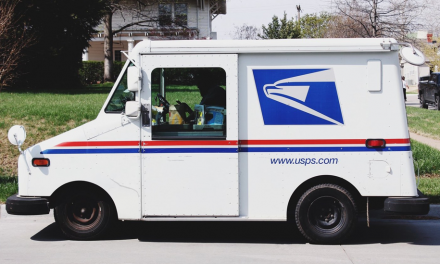
USPS makes profit in October, predicts 50% cut in losses this year
The US Postal Service made a $61m profit in October, and even achieved 5.6% growth in its mail and services revenues compared to the same month last year. And for the full year, the world’s largest postal service is now projecting that it will cut its losses in half, to $7.6bn for the fiscal year 2013.
The struggling Postal Service has been teetering on the edge of liquidity over the past year, defaulting on $11bn worth of payments to the federal government in August and September. Planning on a $14bn loss for fiscal year 2012, USPS actually recorded a $15.9bn loss for the 12 months up to the end of September, including the payments it refused to make.
Latest results show that the festive season peak is now beginning to feed in much-needed funds to help USPS through the winter, with hopes that the US Congress will make critical reforms to its out-of-kilter pension and healthcare payment arrangements.
Not including its federal retiree healthcare obligations and workers compensation adjustment, the “controllable” part of USPS finances in October saw a $286m income.
Total mail volumes in October grew by 9% compared to the same month last year, up to 16bn pieces during the month, while the month’s revenues grew by 5.6% to just over $6bn.
Although the Postal Service’s main money-maker, First Class Mail, saw its volumes shrink by 0.6% in October compared to the same month last year, the product brought in 0.9% more revenue. Standard Mail grew its volumes by 16.1% year-on-year in October, and revenues increased by 10.2%.
Parcels and competitive service figures were obscured by the transfer of products like First Class Parcels from the market-dominant to the competitive portfolio.
The Postal Service saw its operating expenses during October grow by 2% compared to the same month last year, to $5.9bn. Salary costs rose by 2.6%, non-personnel expenses grew by 2.1%, and within that transport costs rose by 8.5%.
FY 2013 Plan
Last week, the Postal Service submitted a financial plan to regulators for the 2013 year, in which it said would likely record a $7.6bn loss for the full year.
However, the prediction includes a $5.6bn payment due to the federal government, which USPS will likely refuse to pay, assuming that the payment is not restructured by Congressional postal reforms.
Not including the payment, and despite expecting “major cost reductions” with a massive downsizing of its network, USPS said its “controllable” loss for the year would be $2bn, a 20% cut in last year’s $2.4bn controllable loss. The Postal Service believes its revenues in 2013 will be $64.9bn, with expenses at $66.7bn.
“Again in FY 2013, there will be insufficient liquidity to make the $5.6bn pre-funding payment for retiree health benefits,” said the USPS plan.
“Even after not making the $11.1bn of pre-funding payments for FY2012 and the $5.6bn pre-funding payment for FY 2013, we estimate that we will end FY 2013 with a cash balance of only $0.8bn.”
The projected cash balance would be less than enough to run the Postal Service for a week.
USPS notes that a 1% error in its sums would have an impact of $1.3bn on its revenue figure predictions, warning of considerable uncertainty in the economic outlook within the US and global situation.
The projections within the plan do not take account of possible legislative reforms.
“In the event of a projected liquidity shortfall, we will prioritise payments to our employees and suppliers to help ensure that the Postal System continues to operate in a quality manner,” said the Postal Service, which added that it will continue to seek a return of multi-billion dollar surplus pension funds.
The 2013 plan projects that USPS mail volumes will decline by 4.2% from 2012 levels, to 153.1bn pieces, with a 6.1% (or 4.2bn piece) decline in First Class Mail, as more customers move to electronic alternatives and because of the weak economy. First Class Mail will still account for more than 42% of USPS revenues, according to the plan.
Standard Mail is expected to see volumes decrease by 3.2% (or 2.5bn pieces) because of the slower economic recovery, competing forms of advertising and the improving technology allowing advertisers to better target their mail.
However, thanks to the continuing growth of commerce, package and shipping volumes are expected to grow by 7% in 2013 to 3.7bn pieces, along similar lines to growth seen in 2012.
Standard Mail Flats
Separately, the US Postal Service has bowed to pressure from regulators this week, to increase its prices for the loss-making Standard Mail Flats service above the level of its inflation-linked price cap.
USPS has been ordered by the Postal Regulatory Commission to bring the service back towards full cost coverage since 2010.
However, the Postal Service has been reluctant to significantly increase rates for the service out of fear it will add financial burdens to the struggling catalogue industry.
Earlier this month, the Commission sent the Postal Service’s 2013 pricing proposals back to L’Enfant Plaza with the complaint that it had not increased Standard Mail Flats prices enough to move it closer towards covering its costs.
USPS had argued that it was making progress towards cost coverage by cutting its operating expenses and providing a more efficient service.
But the regulators – with one commissioner breaking ranks with his colleagues to disagree – said the 2.57% price increase was not enough.
This week, the Postal Service came back with the suggestion that it should instead raise prices by 2.62%.
However, USPS made the revision to its price proposals under protest, complaining that the Postal Regulatory Commission “overstepped its authority” by demanding a higher price for the Standard Mail Flats service than that proposed.
It cited the dissenting postal commissioner Robert Taub in stating: “The approach of the Commission is a step back in time towards its ratemaking role that was abolished with the former Postal Rate Commission.”
Taub, and the USPS, argued that the current remit of the Postal Regulatory Commission is to set out an idea of acceptable pricing based on the annual price cap for market-dominant services, with the Postal Service in the best place to decide on specific prices for services.
USPS said that the additional price increase for its Standard Mail Flats service will bring in more than $4m in additional revenue.
But, the Postal Service said that its hasty revision of the pricing proposals had left no time to determine whether the higher rate will help with cost coverage for the service.
“The Postal Service is uncertain whether increasing the prices for Standard Mail Flats will either improve the product’s cost coverage or make a positive contribution to the Postal Service’s finances,” it said.












